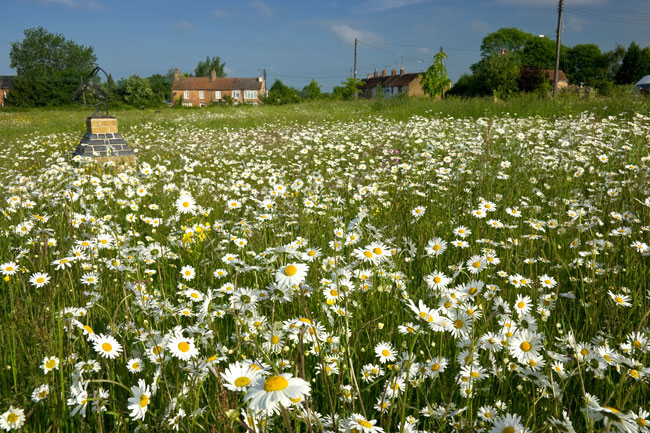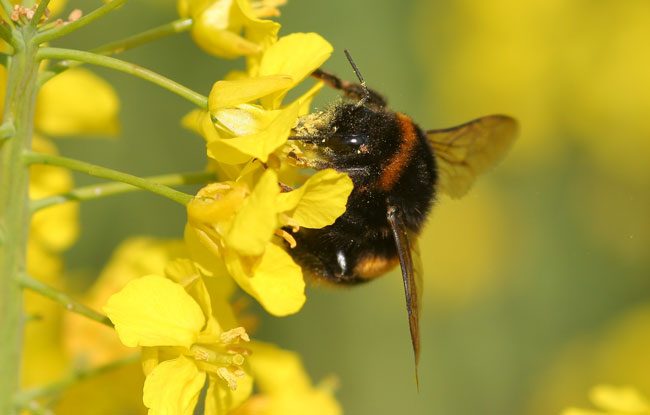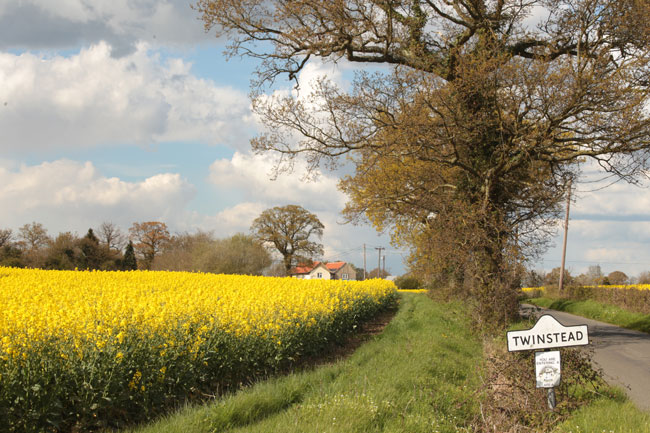This article, written by Dave Goulson, originally appeared in our Spring 2017 issue of Wings Magazine.
In 2013, the European Commission acted to protect bees by restricting the use of three neonicotinoid insecticides within the twenty-eight countries of the European Union. This wasn’t a complete ban on their use—it covered seed treatments only of certain crops that are attractive to bees, such as oilseed rape, and spring-sown cereals—and was to apply for an initial period of just two years, after which the evidence was to be reviewed and the decision would be reconsidered. Nevertheless, this was a controversial act, hailed as a breakthrough by environmental and consumer advocates, and condemned as a backward step by the agricultural and chemical industries.
The Commission’s action came in response to a review by the European Food Safety Authority of the scientific evidence for impacts on bees from the use of three neonicotinoids: clothianidin, imidacloprid, and thiamethoxam. That review, published in January 2013, concluded that the three neonicotinoids posed “an unacceptable risk to bees.” The Commission proposed a two-year moratorium, which was put to a vote by the EU’s member states in a rather complicated and drawn out decision-making process wherein votes were weighted according to the population size of each country rather than a simple one-country-one-vote process. Notwithstanding extensive lobbying on the issue, the ban won a slender majority of the vote. Because of the weighted voting, however, the result was considered inconclusive, and authority for making the decision fell to the Commission, which then imposed the moratorium. The restrictions took effect at the beginning of the following December.
The British government was opposed to the ban—and Britain, as the third most populous country in the EU, carried considerable clout during this process—but once the moratorium had been adopted, Britain had no choice but to comply. Because the ban is only partial, though, neonics remain very widely used on winter-sown cereals and other crops, so total usage continues to rise year over year, according to statistics from the British government’s Department of Farming and Rural Affairs.
The two-year period of the ban expired in late 2015, and the evidence for and against its continuation has been under review since then. It is unclear whether or not the European Union will continue the restrictions on neonics, but in the aftermath of last year’s Brexit referendum the EU’s stance no longer matters as much for Britain. The real question now for the country is whether it will retain the moratorium once having fully withdrawn from the European Union, in about two more years’ time.
There is considerable pressure in Britain to overturn the ban. Britain’s National Farmers Union has actively campaigned against the moratorium and has twice submitted an emergency application to allow the banned insecticides to be used on oilseed rape—known in North America as canola—a major crop that, when in bloom, is a significant foraging resource for the country’s bees. In each case, the NFU argued that the seed treatments were required to avoid heavy crop losses, claiming that a drop in yield of up to 30 percent could be expected if the pesticides were not used. British government statistics, by contrast, showed that there was no such drop in yield, and that yields of other crops affected by the moratorium, including corn and sunflowers, have remained high across Europe.

Despite the apparent lack of losses attributable to the EU moratorium, the efforts to overturn it continue. In autumn of last year, the Society of Chemical Industry held a meeting in London to discuss the question, “Are neonicotinoids killing bees?” This meeting appeared to be a rather one-sided affair: a lot of lobbyists from the agrochemical industry and a hand-picked selection of scientists consisting overwhelmingly of those known to have pro-pesticide leanings or to receive funding from the industry. The meeting’s conclusions are represented by comments made by two attendees, a university researcher and an industry representative, on BBC Radio 4’s Farming Today.
The researcher’s comments can be paraphrased as: “It is all complicated and confusing, and we can’t really be sure what harms bees. The moratorium on neonicotinoid use on flowering crops is forcing farmers to use older, nastier chemicals, about which we know little. That could be worse for bees than using neonics.” The industry representative was more emphatic, stating categorically that in real-world situations neonics do not harm bees. He pointed to a study published in 2015 by Maj Rundlöf (of Sweden’s Lund University) and colleagues. In the largest field trial yet performed for the purpose of examining the effects of neonics on bees, they found no effect on honey bees when their hives were situated next to a treated oilseed rape crop for a year.

Anyone listening to this would be inclined to think that the scientific evidence against neonics is far from clear, and that the moratorium might in fact be doing more harm than good. Of course, this is exactly what the meeting was intended to achieve. The pesticide industry makes billions of dollars every year from these chemicals, and spreading doubt and confusion is an effective tactic to prevent policy makers from taking further action, and to encourage the post-Brexit British government to abandon the EU moratorium altogether.
So let’s look at what we actually do know with certainty about neonics.
These are very widely used neurotoxins, applied to many arable, horticultural, and ornamental crops. They have high persistence, so they last for years in soil, and because they are water soluble they are now routinely found in streams and ponds around the world. They are also found in the pollen and nectar of treated crops, as well as in the pollen and nectar of wildflowers growing nearby.
When we place colonies of honey bees or bumble bees in farmland, the pollen and nectar stores that they gather often contain a cocktail of several neonics (and a bunch of other pesticides, mainly fungicides). Concentrations of neonics in their food typically range from one to as much as ten parts per billion (ppb), sometimes more. If we dose honey bees or bumble bees in the laboratory or in flight cages with food spiked with these same concentrations of neonics (i.e., between one and ten ppb), we get the following range of effects: reduced longevity, diminished immune response, impaired learning, reduced egg laying by queens, and reduced fertility in males. Bumble bee colonies exposed to field-realistic doses or exposed to treated crops in a field setting perform very poorly, grow slowly, and produce few queens. Solitary bees also perform poorly when near treated crops: fewer wild bees are found on the crop itself, and mason bees fail entirely to nest in such areas.
Not every study finds the same effects and a few have found none at all. The variety in research results is presumably due to differences in methods, the particular neonic used and its dosage, the age and health of the bees, the bee species studied, and other such factors. It isn’t simple, but the overwhelming evidence is that neonics do harm bees at field-realistic doses.
When honey bee hives are exposed to treated crops, the deleterious effects on individual bees described above do not seem to translate into significant harm to the hive, at least inside a single year. This conclusion is based on the research of Maj Rundlöf et al. mentioned above, as well as on a couple of studies either performed by or funded by the agrochemical industry itself, which should probably be viewed with a bit of skepticism. Even if we take such studies at face value, they do not rule out the possibility that exposure to neonics might contribute to colony loss in the longer term—for example, by reducing queen longevity, or fecundity, or both—but it does seem that there is no dramatic and immediate effect on honey bee colonies in the way that there is on bumble bees and solitary bees.

It is true that it has not been proven beyond doubt that neonics cause honey bee colonies to die, although it would seem highly likely that having their food laced with neuro toxins at doses that are known to leave individual bees dazed, confused, susceptible to disease, and suffering other sublethal effects isn’t helping honey bee hives cope with their many other problems. Perhaps the very large size of honey bee colonies buffers them against the impacts of pesticides, at least in the short term.
For bumble bees, on the other hand, the case that they are harmed by neonics is iron-clad. There are dozens of studies from laboratory to full field experiments that provide a convincing and coherent body of evidence.
To return to the comments of the meeting attendees, the industry representative was being deliberately disingenuous. In referring to the Swedish study as demonstrating that neonics do not harm honey bees, he was relying on the audience being ignorant of the fact that there are many other types of bee—and of the fact, which he thought better not to mention, that this very study showed devastating effects on bumble bees and solitary bees. Bumble bees are enormously important pollinators of crops and wildflowers, as are some wild solitary bees; in Britain, honey bees contribute no more than perhaps 30 percent of crop pollination, the rest coming from wild insects.

The researcher’s claim that it is all complicated and confusing is misleading at best. It is pretty clear to anyone who is even a little familiar with the scientific literature on the declines in wild bee populations and the losses of honey bee colonies that these phenomena are due to multiple causes, including the loss of flower-rich habitat, the spread of parasites and diseases, and exposure to pesticides. If we want to address bee declines then we need to tackle all of these issues, and we need to do so with urgency, rather than standing around arguing about which is worse, or saying that we need to do more research before we take any action.
The argument that the neonicotinoid ban has forced farmers to use older, nastier chemicals that we know little about is an interesting one, and is a notion I have heard trotted out many times by the agrochemical industry. The neonic ban led British farmers to increase spraying with pyrethroids, on young crops of oilseed rape in September. These are older chemicals, which have been in use for decades and are very well studied. If they were sprayed onto a crop at the time of flowering they would kill lots of bees. Spraying them in September onto seedling oilseed rape, however, is likely to have minimal impacts on bees: most wild bees are gone by then, and honey bees have no reason to be visiting the crop. Pyrethroids have very low persistence compared to neonics, so they will not hang around until the spring when the crop flowers. Of course, it would be better still if farmers investigated nonchemical means of managing their crop pests, adopting an integrated pest management approach whenever possible, but that is for another day.
Despite what the agrochemical industry and its supporters claim, the evidence linking neonics to declining bee populations is overwhelming. But industry will continue to say that black is white, that neonics don’t harm bees, just as some continue to deny the existence of climate change because it suits their financial interests. As the American author Upton Sinclair once said, “It is difficult to get a man to understand something when his salary depends on him not understanding it.”
We urgently need to put pressure on our politicians to ensure that they ignore such prevarications and take proper steps to prevent the wholesale pollution of our countryside with persistent neurotoxins. More broadly, we need to find ways to reduce the grip of the chemical manufacturers on the way we grow food. Regardless of Brexit—and indeed regardless of whether one likes or does not like Brexit—it is crucial for Britain to continue the moratorium on neonicotinoid use that was initially put in place by the European Commission. If we don’t steer away from industrial, chemical farming towards more sustainable methods, we will lose bees—and much more of our wildlife—forever.
Dave Goulson is a professor of biology at the University of Sussex in Britain, where he specializes in the ecology and conservation of bumble bees. He is the author of A Sting in the Tale and A Buzz in the Meadow, and of the recently released Bee Quest.



